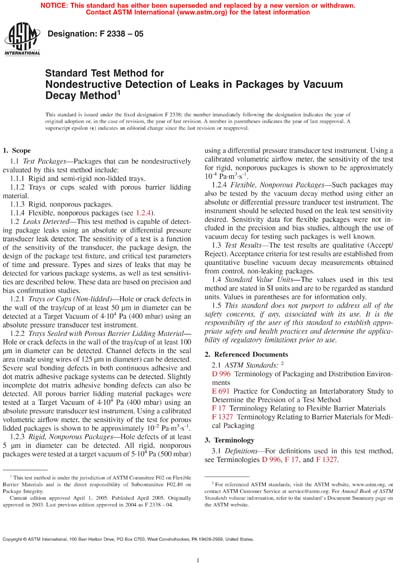Historical
ASTM F2338-05
Standard Test Method for Nondestructive Detection of Leaks in Packages by Vacuum Decay Method
1.1 Test Packages—Packages that can be nondestructively evaluated by this test method include:
1.1.1 Rigid and semi-rigid non-lidded trays.
1.1.2 Trays or cups sealed with porous barrier lidding material.
1.1.3 Rigid, nonporous packages.
1.1.4 Flexible, nonporous packages (see 1.2.4).
1.2 Leaks Detected—This test method is capable of detecting package leaks using an absolute or differential pressure transducer leak detector. The sensitivity of a test is a function of the sensitivity of the transducer, the package design, the design of the package test fixture, and critical test parameters of time and pressure. Types and sizes of leaks that may be detected for various package systems, as well as test sensitivities are described below. These data are based on precision and bias confirmation studies.
1.2.1 Trays or Cups (Non-lidded)—Hole or crack defects in the wall of the tray/cup of at least 50 μm in diameter can be detected at a Target Vacuum of 4·104 Pa (400 mbar) using an absolute pressure transducer test instrument.
1.2.2 Trays Sealed with Porous Barrier Lidding Material—Hole or crack defects in the wall of the tray/cup of at least 100 μm in diameter can be detected. Channel defects in the seal area (made using wires of 125 μm in diameter) can be detected. Severe seal bonding defects in both continuous adhesive and dot matrix adhesive package systems can be detected. Slightly incomplete dot matrix adhesive bonding defects can also be detected. All porous barrier lidding material packages were tested at a Target Vacuum of 4104 Pa (400 mbar) using an absolute pressure transducer test instrument. Using a calibrated volumetric airflow meter, the sensitivity of the test for porous lidded packages is shown to be approximately 10-2 Pam3s-1.
1.2.3 Rigid, Nonporous Packages—Hole defects of at least 5 μm in diameter can be detected. All rigid, nonporous packages were tested at a target vacuum of 5·104 Pa (500 mbar) using a differential pressure transducer test instrument. Using a calibrated volumetric airflow meter, the sensitivity of the test for rigid, nonporous packages is shown to be approximately 10-4 P·am3s -1.
1.2.4 Flexible, Nonporous Packages—Such packages may also be tested by the vacuum decay method using either an absolute or differential pressure tranducer test instrument. The instrument should be selected based on the leak test sensitivity desired. Sensitivity data for flexible packages were not included in the precision and bias studies, although the use of vacuum decay for testing such packages is well known.
1.3 Test Results—The test results are qualitative (Accept/Reject). Acceptance criteria for test results are established from quantitative baseline vacuum decay measurements obtained from control, non-leaking packages.
1.4 Standard Value Units—The values used in this test method are stated in SI units and are to be regarded as standard units. Values in parentheses are for information only.
1.5 This standard does not purport to address all of the safety concerns, if any, associated with its use. It is the responsibility of the user of this standard to establish appropriate safety and health practices and determine the applicability of regulatory limitations prior to use.
ASTM International [astm]

